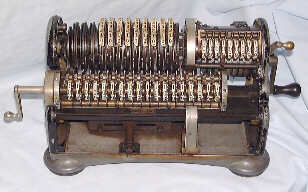| Return
to main text |
Mechanical Multiplication
 Before multiplication and division can be explained, it is
necessary to know a little more about the calculator. Firstly,
the figure wheels of the output register and their associated
transfer gears and carry cams are mounted on a movable carriage
which can be shifted to the left or to the right. In the
illustration it has been shifted six places to the left. There is
a movable pointer just below register two which indicates which
column of figures is active (in this case, column six).
Before multiplication and division can be explained, it is
necessary to know a little more about the calculator. Firstly,
the figure wheels of the output register and their associated
transfer gears and carry cams are mounted on a movable carriage
which can be shifted to the left or to the right. In the
illustration it has been shifted six places to the left. There is
a movable pointer just below register two which indicates which
column of figures is active (in this case, column six).
Secondly, register two, on the upper right of the machine,
will increment the active column (and if necessary carry to the
left) each time the crank handle completes one rotation.
Having got that over with, we can proceed and think about
multiplying 456 by 123.
One way of doing this is to enter 456 on the setting levers
and then turn the handle one hundred and twenty three times. This
is the sort of thing that people used to do when they got bored
but there is an easier way.
- Shift the carriage as far LEFT as it will go
- Set up 456 on the setting levers
- Rotate the crank three times. This multiplies 456 by three,
the registers show:-
456 000000003
^
000000000000001368
- Shift the carriage once to the right
- Rotate the crank twice. This multiplies 456 by 20 and adds
the result into the output register. The registers now show:-
456 000000023
^
000000000000010488
- Shift the carriage once to the right.
- Rotate the crank handle once. This multiplies 456 by 100 and
adds in the result. The registers now show:-
456 000000123
^
000000000000056088
- The calculation is complete.
Mechanical Division
Division is accomplished by repeated subtractions, but the
nice thing about division is that there is a little bell that
rings every so often during the calculation.
We are going to divide 456 by 123
- Shift the carriage as far to the RIGHT as it will go
- Set up 456 on the setting levers
- Rotate the crank once FORWARDS to transfer this to the output
register - register 2 is incremented - the registers show:-
456 100000000
^
000000045600000000
- Clear the setting levers and register 2
000 000000000
^
000000045600000000
- Set up 123 on the setting levers
- Set the multiply/divide lever to DIVIDE - this makes register
2 increment when the crank is turned backwards - some calculators
will take care of this automatically.
- Rotate the crank once BACKWARDS
123 100000000
^
000000033300000000
- Rotate the crank once backwards
123 200000000
^
000000021000000000
- Rotate the crank once backwards
123 300000000
^
000000008700000000
- Rotate the crank once backwards
123 400000000
^
999999996400000000 (ping!!) - Warning -
we have gone too far
- Rotate the crank once FORWARDS
123 300000000
^
000000008700000000
- Shift the carriage one place LEFT
123 300000000
^
000000008700000000
- Rotate the crank once BACKWARDS
123 310000000
^
000000007470000000
- Rotate the crank BACKWARDS until the nines come up again and
the bell rings
123 380000000
^
999999998860000000 (ping!!)
- Rotate the crank FORWARD - we'll get it right next time
123 370000000
^
000000000090000000
- Shift the carriage one place LEFT
123 370000000
^
000000000090000000
- 123 is bigger than 90 so we need to shift again ...
- Shift the carriage one place LEFT
123 370000000
^
000000000090000000
- Now, rotate the crank BACKWARDS until JUST BEFORE all the
nines come up
123 370700000
^
000000000003900000
- Shift the carriage one place LEFT
123 370700000
^
000000000003900000
- Rotate the crank BACKWARDS until JUST BEFORE all the nines
come up
123 370730000
^
000000000000210000
And so on....
The result is 3.7073... (the decimal place
has to be worked out by inspection)
..... and you would not believe just how fast some people
could do calculations like this.
| Return to
main text | Go to Top |
29-Jan-2002
Images and Text Copyright © 2002 A.
Audsley, All Rights Reserved
 Before multiplication and division can be explained, it is
necessary to know a little more about the calculator. Firstly,
the figure wheels of the output register and their associated
transfer gears and carry cams are mounted on a movable carriage
which can be shifted to the left or to the right. In the
illustration it has been shifted six places to the left. There is
a movable pointer just below register two which indicates which
column of figures is active (in this case, column six).
Before multiplication and division can be explained, it is
necessary to know a little more about the calculator. Firstly,
the figure wheels of the output register and their associated
transfer gears and carry cams are mounted on a movable carriage
which can be shifted to the left or to the right. In the
illustration it has been shifted six places to the left. There is
a movable pointer just below register two which indicates which
column of figures is active (in this case, column six).